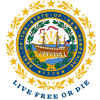Forest Health
Resources for landowners and interested citizens to monitor and understand forest health issues in New Hampshire.
The Forest Health Program was established as the "white pine blister rust control program" in 1917. In 1965, the WPBR control program was expanded into a more general "Forest Insect and Disease Program" with as many as eight full time specialists working on pest issues throughout the state. In 1997, the forest insect and disease program was again broadened to the title "Forest Health Section" to reflect the increased scope of forest health issues beyond just insects and diseases.
The current Forest Health Program is staffed with one forest entomologist/pathologist and two forest health specialists.
Our mission is to:
- Provide and maintain forest and tree pest control programs in coordination with other state and federal agencies.
- Provide detection, identification, evaluation and assessment of forest pest problems on a statewide basis.
- Provide leadership in all forest pest problems, keeping current through systematic detection programs and close liaison with other sources of information.
- Maintain close contact with all segments of the forestry profession in forest insect and disease matters.
- Provide service for identification of forest pests cooperating in this regard with the UNH Cooperative Extension, NH Department of Agriculture, U.S. Department of Animal and Plant Health Inspection Service, and the U.S. Forest Service.
- Assist and coordinate in the control of forest insects and diseases, cooperating with the U.S Forest service, Department of Agriculture, and the New Hampshire landowners and landowner associations.
The Forest Health Program also implements and enforces forest health regulations to prevent the introduction or spread of exotic insects or diseases. Regulated items in New Hampshire include emerald ash borer, hemlock woolly adelgid, gooseberries and currants, the alternate host for white pine blister rust.




